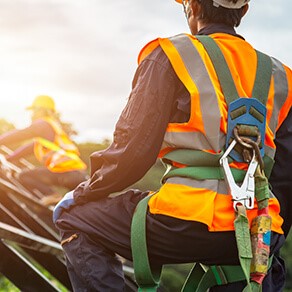
No Accident – Identifying the Five Biggest Safety Risks to Your Workers
Forgive the pun, but a culture of safety doesn’t happen by accident. Planning is key to minimizing the hazards and practices that lead to mishaps and disasters. To help categorize the most widely occurring — and lethal — risks on any construction site, let’s focus on what OSHA calls the “fatal four” and then add one more.
1. Falls
Falls are the leading cause of death in construction. Contributing factors typically include unstable working surfaces, misuse of — or failure to use — fall protection equipment, and human error. During preconstruction of a given project, think about what the job will entail. What kind of equipment will be used? What will the conditions be (for example, wet or icy)? Will employees work from heights of six feet or more above ground level? Will they use ladders or stairways?
With these questions answered, you can determine what measures to take. For instance, you may need to deploy aerial lifts or elevated platforms to provide safer elevated working surfaces. You should inspect ladders before use or ensure stairways have treads and handrails. Using perimeter protection (such as safety nets or guardrails with toeboards), fall arrest systems (body harnesses), clearly marked floor opening covers and restraint systems can prevent many deaths and injuries from falls.
2. “Struck-bys”
Construction workers can be struck by many things: heavy equipment and vehicles; falling, swinging or flying objects; or bricks or cinder blocks tumbling from unfinished walls. Even dropping a small tool could cause serious — even fatal — injury. Ensure your workers are wearing high-visibility clothing, hard hats, and appropriate eye and face protection. Tool tethering is also a best practice to follow.
Vehicles and equipment are particularly dangerous hazards to address. For instance, “backover” incidents occur when a backing vehicle strikes a person. Train workers on the ground to act as spotters, or use warning devices such as in-vehicle display monitors and radar or sonar proximity detection devices. Other strategies include strictly separating employees on foot from operating equipment (where possible) and creating internal traffic control patterns to prevent vehicles from needing to back up.
3. Electrical Hazards
Workers face many electrocution risks on jobsites, including exposed or faulty wiring, hidden power lines, and wet conditions while outlets are exposed. Yet electrical hazards are arguably among the most overlooked risks — probably because we all plug and unplug items into and from outlets every day without thinking about the dangers.
Virtually every contractor knows to contact local utilities to identify buried lines before digging. But take extra care with such routine steps when working on a “rush job.” Ensure workers are duly informed of these locations as well as taught to maintain safe-distance requirements from power lines — especially when operating equipment and working on ladders, scaffolds and other platforms.
If you don’t have one already, be sure to set up a system for regularly checking electrical tools and equipment for OSHA compliance, as well as damage and defects. For example, extension cords must have grounding prongs. Electrical tools must be properly grounded, too, unless they’re double-insulated. Promptly replace frayed, damaged or worn cords and cables.
4. “Caught in or Between”
Examples of these types of accidents include getting pinned or compressed by equipment, objects or materials. Workers can also be caught in collapsing structures or jobsite locations. And they’re often trapped in or between moving or rotating equipment, such as miter saws, conveyors and rotating pump shafts.
Being caught in or between hazards is especially common in trench and excavation sites. A general safety rule of thumb is that workers should never enter a trench or excavation that’s five feet or deeper without an adequate protective system in place (such as sloping, shoring, benching or a trench shield).
As is the case with many safety precautions, it’s not enough to mandate that they be followed. Regularly audit your own jobsites and thoroughly investigate any incidents that occur.
5. Fire Hazards
A fire can be devastating, not only because it can cause injury and loss of life, but also because it can damage property and cause extensive project delays. Many construction companies now implement formal fire prevention programs to ensure all bases are covered.
Such a program would include identifying and marking hazardous materials and jobsite locations, putting up signage to indicate where fire extinguishing equipment is located, and enforcing strict policies for the storage and transport of flammable materials and substances.
Your equipment- and vehicle-use policies must reflect fire safety as well. For example, workers need to follow best practices when using small-engine machines — such as waiting for the machine to cool down before refueling.
SIDEBAR
Take Control
Safety is important, first and foremost, because the well-being of your workers is important. But whether your jobsites are safe also directly impacts the cost of running your construction company. Workers’ compensation costs, for instance, can spiral out of control after just a few on-site mishaps. The key to managing these costs is to lower your company’s risk. To that end:
1. Commit to Safety. Communicate and enforce safe work rules and establish a task force of employees and managers to identify emerging hazards.
2. Classify Employees Correctly. Maintain up-to-date payroll records and make sure employees’ job risk classifications are accurate and match those used by your state.
3. Maintain Safe Working Conditions. Regularly service equipment and vehicles and inspect facilities (including signage, ventilation, lighting, emergency exits and supply storage).
4. Invest in Ergonomics. Properly fitted equipment and tools can help reduce the risks of injury from physical stress and fatigue.
Contact us with any questions.
